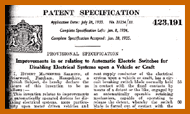Read a Patent Specification

The US Patent Office requirements for the written description and patent enablement are spelled out in 35 USC 112. But how do you read a specification?
At the risk of sounding linear and mechanical - I believe the best way to describe how to read a patent specification is to start at the beginning and discuss each subsection of a specification. The specification is the section that begins immediately after the drawings. From the beginning:
Title This one is not complicated - it is the title. The title is chosen by the applicant and in most cases is agreed to by the examiner.
Cross Reference to Related Applications Many patents have related applications - there may be one or more provisionals that preceded this application - or there may be divisionals, continuations, or continuations-in-part. Each is listed, along with there appropriate numbers and dates.
Statement Regarding Federally Sponsored Research or Development You will not find this section in all patents, but if the invention was developed under a contract from the US Government, this section will spell out that the Government retains some rights in the patent. These rights are normally called out in the particular contract involved.
Background of the Invention: The Background is usually divided into two parts:
- (1) Field of the Invention: This is a very broad description of the area of technology into which the patent falls. Traditionally, the field of the invention is stated in two sentences. The first is sort of a paraphrasing of the class definition, the second is similar to a subclass definition. For example, "The invention pertains to cables for interconnecting electronic devices, more particularly to mechanisms for identifying characteristics of such cables.
(2) Description of the Related Art: This section discusses the "prior art" - that is, what was known before the invention. This will often include references to specific patents or other documents, and might include a discussion of shortcomings of prior patents. There is then a rather general statement that the invention of this patent will address those shortcomings.
Brief Summary of the Invention: A brief summary or general statement of the invention. The summary usually describes the actual invention, not the whole disclosure. As such, it is quite common to see the summary be a careful rewriting of the independent claims. The summary may also describe how the invention solves the shortcomings indicated in the Background of the Invention. Some practitioners also include a paraphrase of the Abstract in the Brief Summary.
Brief Description of the Drawings: A reference to and very brief description of each Figure in the drawing(s). The best practice is one sentence only. Example - "Fig. 5 is a schematic view of the cable of the invention."
Detailed Description of the Invention: A description of the preferred embodiment(s) of the invention. The description should thoroughly and accurately describe the various embodiments of the invention in great detail by making specific references to the drawings and linking the explanation to the reference numbers of the Drawings. Every figure should be explained, and, at least in theory, every reference number in the drawing mentioned in the detailed description. If both apparatus and method claims are in the claims then both should be described in the Detailed Description.
You will find that all patents follow this patent, with some modifications. If you want to read a patent specification you can refer to this simple primer to understand how to do that.
Links
Read a Patent Specification
Return to the Top of This Page
The Business of Patents Home Page
Return to Home Page
Patent Law
Return to the Patent Law Page.
Mike Ervin
Mike Ervin - Cost Effective Small Business Patent Protection.
Contact Me
If you have any questions on on this site - please feel free to contact me.